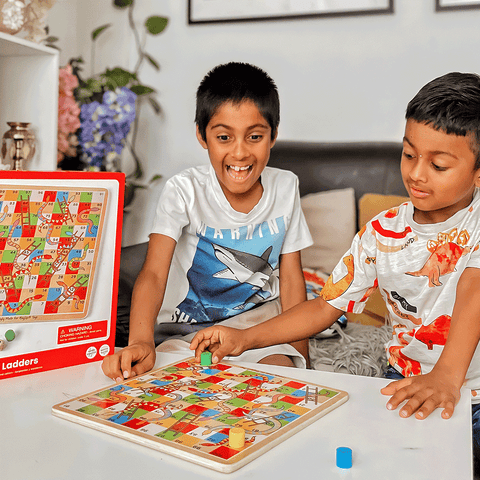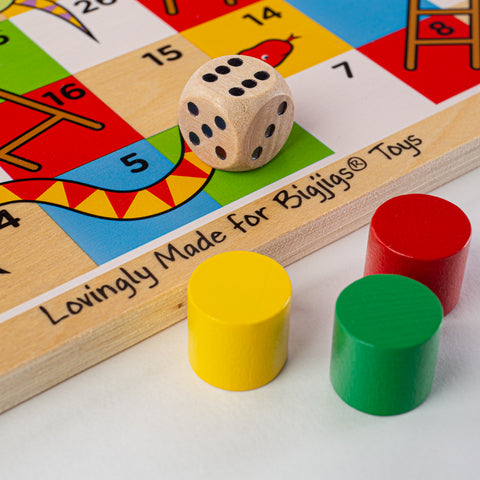
How To Play Snakes And Ladders
Invented in ancient India, Snakes and Ladders is a much-loved family board game with a fascinating hiss-tory! It was originally named Moksha Patam and is believed to have been created hundreds of years ago by 13th Century poet Saint Gyandev. Traditionally, the game was designed to teach Hindu values to children and illustrate the difference between good and evil, with the ladders representing virtues and snakes representing vices.
Moksha Patam was brought to Victorian England in the late 19th Century, where it was given a new name and a few modifications, including the removal of its earlier religious connotations. In 1943, the game was also launched in America under the name Chutes and Ladders.

Today, Snakes and Ladders is a favourite kids board game played in family homes all over the globe. Inspired by its centuries-old heritage, our Snakes and Ladders Game features a traditional wooden board with colourful illustrations to capture children’s imaginations.
Need a little reminder on how to play? Have a read of our guide...
What Are The Official Rules Of Snakes And Ladders?
- Each player places their counter on square 1 then rolls the dice - the player who rolls the highest number gets to take the first turn
- Players then take it in turns to roll the dice and move their counters forward to the number of spaces as shown on the dice
- If a player lands on a square with the bottom of a ladder pictured, they get to climb to the top of that ladder - skipping a row or more of squares!
- If a player lands on a square with the head of a snake pictured, they must slide down to the end of the snake’s tail
- The first player to land on square 100 wins! But they must roll the exact number that’ll get them to the final square, otherwise they’ll have to bounce off and move back the number of spaces remaining on that throw (more on this below)
What happens when you throw a six in Snakes and Ladders?
If a player throws a six in the Snakes and Ladder game, they get an extra turn. However, players are not allowed to throw three sixes in a row. If this happens, the third six is void and the turn is passed to the next player.
How do you end a game of Snakes and Ladders?
The end rule of Snakes and Ladders keeps the game interesting! To win, you must roll the dice the exact number of places that’ll get you to the 100th square. If you don’t, your counter must bounce back the remaining number of spaces left on the dice. So, say you were on square 99 and you rolled a 5, you would move one place to square 100, then back four places to square 96.

How long is the average game of Snakes and Ladders?
On average, it takes around 30 minutes to finish a typical game of Snake and Ladders, but of course this totally depends on the numbers you roll, how many ladders you climb up and how many snakes strike you down!
Is Snakes and Ladders a luck game?
While its ancient Indian roots involved underlying lessons in morality and religious symbolism, Snakes and Ladders is actually a zero-choice board game based on 100% luck, which makes it the best board game for youngsters to play.

What age do kids understand Snakes and Ladders?
The Snake and Ladders game is ideally suited for children aged 3+ years. By this age, most kids will be able to count to six, roll the dice themselves and move their counter to the correct squares.
What are the benefits of Snakes and Ladders game for children?
The game Snakes and Ladders has heaps of benefits for young children, including but not limited to:
- Improving counting and numeracy skills
- Language and vocabulary
- Fine motor skills
- Turn-taking and patience
- Enhancing social skills
- Relationship building
- Family bonding time
- Encouraging mindfulness
